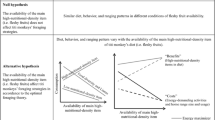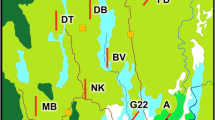Abstract
I studied brown capuchins (Cebus apella)in primary forest in French Guiana. They displayed different feeding and ranging patterns in response to changes in fruit availability and distribution. When fruit was scarce and patchily distributed, foliage/stem feeding and invertebrate foraging was high, and capuchins limited their daily movement to <2 km, focusing on large fruit patches. When fruit was in average supply and scattered throughout the forest, the proportions of foliage/stems and invertebrates in the diet decreased, and the day range length increased to 2.8 km. When fruit was abundant and widespread, foliage/stems were rarely eaten, while invertebrate foraging increased, and. the daily locomotor distance was reduced to 2 km.
Similar content being viewed by others
References
Altmann, J. (1974). Observational study of behavior: Sampling methods.Behaviour 49: 227–265.
Altmann, S. A., and Altmann, J. (1970).Baboon Ecology: African Field Research, University of Chicago, Chicago.
Bennett, E. L. (1986). Environmental correlates of ranging behaviour in the banded langur,Presbytis melalophos.Folia Primatol. 47: 26–38.
Boinski, S. (1987). Habitat use by squirrel monkeys (Saimiri oersledi) in Costa Rica.Folia Primatol. 49: 151–167.
Brown, A. D., and Zunino, G. E. (1990). Dietary variability inCebus apella in extreme habitats: Evidence for adaptability.Folia Primatol. 54: 187–195.
Charles-Dominique, P., Atramentowicz, M., Charles-Dominique, M., Gérard, H., Hladik, A., Hladik, C., M., and Prévost, M. F. (1981). Les mammifêres frugivores arboricoles nocturnes d’une forêt guyanaise: Inter-relations plantes-animaux.Rev. Ecol. (Terre Vie) 35: 341–435.
Chivers, D. J. (1974). The siamang in Malaya: A field study of a primate in a tropical rain forest.Contr. Primatol. 4: 1–335.
Clutton-Brock, T. H. (1975). Feeding behaviour of red colobus and black and white colobus in East Africa.Folia Primatol. 23: 165–207.
Clutton-Brock, T. H. (1977).Primate Ecology: Studies of Feeding and Ranging Behavior in Lemurs, Monkeys, and Apes. Academic Press, London.
Dawson, G. A. (1979). The use of time and space by the Panamanian tamarin,Saguinus oedipus.Folia Primatol. 31: 253–284.
Devore, I., and Hall, K. R. L. (1965). Baboon ecology and human evolution. In Devore, I. (ed.),Primate Behavior: Field Studies of Monkeys and Apes, Aldine Press, Chicago, pp. 335–367.
Freese, C. H., and Oppenheimer, J. R. (1981). The capuchin monkeys, genusCebus. In Coimbra-Filho, A. F., and Mitermeier, R. A. (eds.),Ecology and Behavior of Neotropical Primates, Vol 1, Academia Brasileira de Ciências, Rio de Janeiro, pp. 331–390.
Gautier-Hion, A., Gautier, J. P., and Quris, R. (1981). Forest structure and fruit availability as complementary factors influencing habitat use by a troop of monkeys (Cercopithecus cephus).Rev. Ecol. (Tern Vie) 35: 511–536.
Hladik, A., and Hladik, C. M. (1969). Rapports trophiques entre végétation et primates dans la forêt de Barro Colorado, Panama.Rev. Ecol (Terre Vie) 23: 25–117.
Isbell, L. A. (1983). Daily ranging behavior of red colobus (Colobus badius tephrosceles) in Kibale Forest, Uganda.Folia Primatol. 41: 34–49.
Julliot, C. (1992).Utilisation des Ressources Alimentaires par le Singe Hurleur Roux, Alouatta seniculus(Atelidae, Primates), en Guyane: Impact de la Dissémination des Graines sur la Régénération Forestière. Thèse de l’Universite de Tours, Tours.
Kinzey, W. G. (1981). The titi monkeys, genusCallicebus. In Coimbra-Filho, A. F., and Mitermeier, R. A. (eds.),Ecology and Behavior of Neotropical Primates, Vol. 1, Academia Brasileira de Ciências, Rio de Janeiro, pp. 241–276.
Larpin, D. (1993).Les Formations Ligneuses sur un Inselberg de Guyane Française: Etude Floristique, Structurale et Dynamique. Thèse de l’Université Paris VI, Paris.
Marsh, C. W. (1981). Ranging behaviour and its relation to diet selection in Tana River red colobus (Colobus badiwn rufomitratus).J. Zool. London 195: 473–492.
McKey, D. B., and Waterman, P. G. (1982). Ranging behaviour of a group of black colobus (Colobus satanus) in the Douala-Edea Reserve, Cameroon.Folia Primatol. 39: 265–304.
Milton, K. (1980).The Foraging Strategy of Howler Monkeys, Columbia University Press, New York.
Mittermeier, R. A., and van Roosmalen, M. G. M. (1981). Preliminary observations on habitat utilization and diet in eight Surinam monkeys.Folia Primatol. 36: 1–39.
Newton, P. (1992). Feeding and ranging patterns of forest hanuman langurs (Presbytis entellus).Int. J. Primatol. 13: 245–285.
Pearson, D. L., and Derr, J. A. (1986). Seasonal patterns of lowland forest floor arthropod abundance in southeastern Peru.Biotropica 18: 244–256.
Perry, D. R. (1978). A method of access into the crowns of emergent and canopy trees.Biotropica 10: 155–157.
Poole, R. W. (1974).An Introduction to Quantitative Ecology, McGraw-Hill, New York.
Rasmussen, D. R. (1979). Correlates of patterns of range use of a troop of baboons (Papio cynocephalus). I. Sleeping sites, impregnable females, births and male emigrations and immigrations.Anim. Behav. 27: 1098–1112.
Robinson, J. G. (1986).Seasonal Variation in Use of Time and Space by the Wedge-Capped Capuchin Monkey. Cebus olivacieus:Implications for Foraging Theory, Smithson. Contrib. Zool., No. 431.
Rylands, A. B. (1986). Ranging behaviour and habitat preference of a wild marmoset group,Callithrix humeralifer (Callitrichidae, Primates).J. Zool. Lond. 210: 489–514.
Sabatier, D. (1985). Saisonnalité et determinisme du pic de fructification en forêt guyanaise.Rev. Ecol. (Terre Vie) 40: 289–320.
Sabatier, D., and Prèvost, M. F. (1992). Variations du peuplement forestier à l’échelle stationnelle: Le cas de la station des Nouragues en Guyane française.Actes de l’Atelier sur l’amènagement et la conservation de l’é cosystème forestier tropical humide, 12–16 Mars, MAB-UNESCO, pp. 169–187.
Sarthou, C. (1992).Dynamique de la Végétation Pionnière sur un Inselberg en Guyane Française, Thèse de l’Université Paris VI, Paris.
Struhsaker, T. T. (1974). Correlates of ranging behavior in a group of red colobus monkeys (Colobus badius tephrosceles).Am. Zool. 14: 177–184.
Tenaza, R. R. (1975). Territory and monogamy among Kloss’ gibbons (Hylobates klossii) in Siberut Island, Indonesia.Folia Primatol. 24: 68–80.
Terborgh, J. (1983).Five New World Primates: A Study in Comparative Ecology, Princeton University Press.
van Schaik, C. P., van Noordwijk, M. A., deBoer, J. R., and den Tonkelaar, I. (1983). The effect of group size on time budgets and social behavior in wild long-tailed macaques (Macaca fascicularis).Behav. Ecol. Sociobiol. 13: 173–181.
Waser, P. M. (1976).Cercocebus albigena: Site attachment, avoidance and intergroup spacing.Am. Nat. 110: 911–935.
Wolda, H. (1978). Seasonal fluctuations in rainfall, food and abundance of tropical insects.J. Anim. Ecol. 47: 369–381.
Wolda, H., and Fisk, F. W. (1981). Seasonality of tropical insects. II. Blattaria in Panama.J. Anim. Ecol. 50: 827–838.
Wrangham, R. W. (1980). An ecological model of female bonded primate groups.Behaviour 75: 262–300.
Zhang, S.-Y., and Wang, L.-X. (1995a). Comparison of three fruit census methods in French Guiana, (submitted for publication).
Zhang, S.-Y., and Wang, L.-X. (1995b). Fruit consumption and seed dispersal ofZiziphus cinnamomum (Rhamnaceae) by two sympatric primates (Cebus apella and Ateles paniscus) in French Guiana (submitted for publication).
Author information
Authors and Affiliations
Rights and permissions
About this article
Cite this article
Zhang, SY. Activity and ranging patterns in relation to fruit utilization by Brown Capuchins (Cebus apella) in French Guiana. Int J Primatol 16, 489–507 (1995). https://doi.org/10.1007/BF02735799
Received:
Revised:
Accepted:
Published:
Issue Date:
DOI: https://doi.org/10.1007/BF02735799




